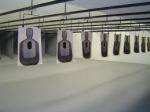The Washington Post can usually be counted on to carry an article now and again that challenges the gun lobby on issues related to gun ownership, gun violence, or other contentious topics related to guns. Recall that it was The Post which carried a multi-part, detailed series on gun dealers who sold most of the crime guns in northern Virginia, reportage which no doubt helped guide the Brady Organization to start up its “rotten apples” campaign against rogue dealers in Chicago and other locations.
 Now the Post has turned around and given a large, online editorial space to Michael Rosenwald, who went across the Potomac River to Manassas and evidently spent some time at the Elite Shooting Sports range, and then wrote an article describing the emergence of a new trend in the gun industry, something which he calls “guntry” ranges that allow patrons to rent guns and bang away either on a membership or per-try basis. Most shooting ranges have a collection of guns that can be rented or used by visitors (the real revenue at a range is from ammunition sales) but what makes ranges like Elite different, according to Rosenwald, is these enterprises cater to a “younger, more affluent, style-focused, increasingly female and even environmentally conscious” customer base, quite unlike the gritty, hard-core, blue-collar gunnies and trigger-heads that usually hang around the local gun range.
Now the Post has turned around and given a large, online editorial space to Michael Rosenwald, who went across the Potomac River to Manassas and evidently spent some time at the Elite Shooting Sports range, and then wrote an article describing the emergence of a new trend in the gun industry, something which he calls “guntry” ranges that allow patrons to rent guns and bang away either on a membership or per-try basis. Most shooting ranges have a collection of guns that can be rented or used by visitors (the real revenue at a range is from ammunition sales) but what makes ranges like Elite different, according to Rosenwald, is these enterprises cater to a “younger, more affluent, style-focused, increasingly female and even environmentally conscious” customer base, quite unlike the gritty, hard-core, blue-collar gunnies and trigger-heads that usually hang around the local gun range.
Rosenwald mentions other guntry locations in South Beach, Florida, and a few spots around the country, all of which are catering, according to him, to a “new breed” of shooter. And he paints a pretty accurate description of what he refers to as these “shooting retreats,” which, by the way, are usually part of a complex that includes a cigar lounge, a high-end restaurant, catering venues and other amenities that draw younger folks with a buck to spend.
That’s fine as far as it goes. But the moment that Rosenwald stops writing about what he knows – business – and begins writing about what he doesn’t know – the gun business – mistakes and misstatements abound. The truth is that there has yet to be any connection between the development of this business model, successful or not, and a penetration of gun sales into the younger, more affluent and more diverse population groups. Try as they might, the gun lobby has been unable to persuade racial minorities, women or more affluent/educated folks of the value of owning guns, and Rosenwald’s comment that gun sales are now “leveling out” is remarkably disingenuous. Does he really believe that a 40% decline in revenues of gun makers like Smith & Wesson and Ruger, along with major job layoffs, constitutes simply a leveling out? What it means is that once Obama-fear disappeared, the gun industry has not been able to attract buyers beyond the traditional White, older, blue-collar demographic, even if the kids on occasion want to stop playing video shooting games and try the real thing.
Rosenwald quotes the NSSF that Americans spend $10 billion yearly on target shooting, but he also says that the industry as a whole tracked up $15 billion last year in sales. Is he claiming that 2/3 of the revenue of the gun industry comes from people who just go out somewhere, set up a target and shoot their guns? That’s all fine and well except that hunters spend more than $38 billion annually on their hobby, and if you’re going to include in target shooting such expenditures as the cost of driving back and forth to the range, don’t you have to compare this number to the cost of driving back and forth to where someone went to hunt?
An article about the gun industry based on the unqualified statements of the NSSF may fill an op-ed piece for The Post, but it doesn’t help us understand the current debate about guns. If it were the case that gun makers were finding new markets, then perhaps the whole discussion about gun safety would need to change. Rosenwald may have found a new way in which Millennials spend their money, but shooting a gun and becoming a shooter are two very different things.




Recent Comments